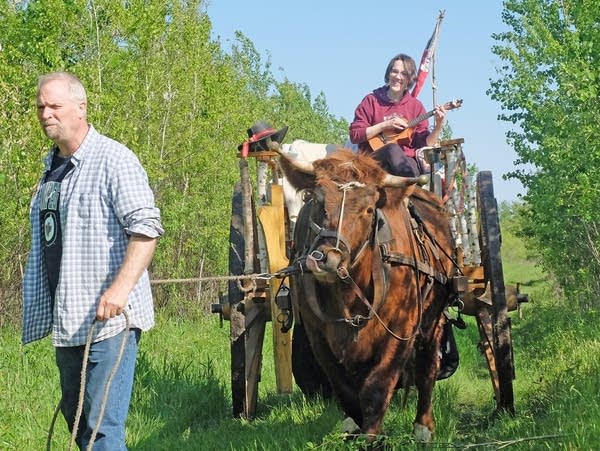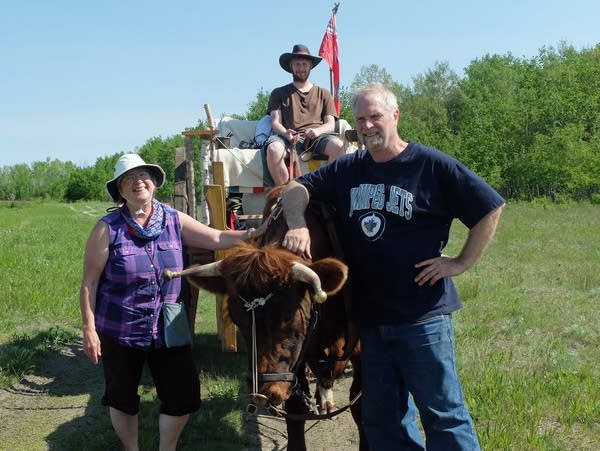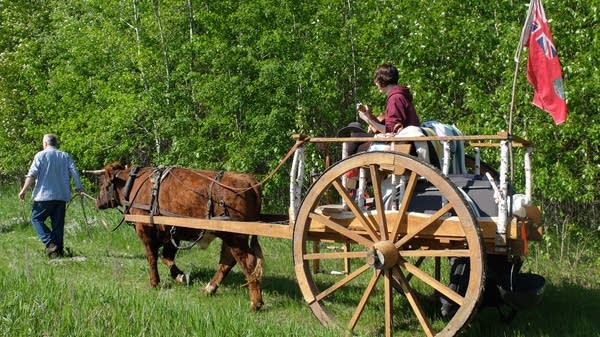Reliving 150-year-old history a step, and a creak, at a time

Go Deeper.
Create an account or log in to save stories.
Like this?
Thanks for liking this story! We have added it to a list of your favorite stories.
An oxcart with its wooden wheels and axles is often heard before it's seen. The wood parts rubbing together screech and groan like some giant out-of-tune fiddle.
"There's lots of interesting descriptors on the hellish sounds of an oxcart train coming down the road," said Terry Doerksen as he and Zik (Zeke) the ox traveled on a narrow track through the woods in a state wildlife management area in Marshall County.
"I'm guessing this is the longest stretch right here of the original Red River Trail," he said.
The Red River Trail, more commonly known in Minnesota as the Pembina Trail, was used in the mid-1800s. Ox carts, often driven by the Métis — Indigenous people who lived and traded along Canadian fur trade routes — traveled in trains sometimes hundreds of oxen and carts long that took hours to pass by a home or small town.
Turn Up Your Support
MPR News helps you turn down the noise and build shared understanding. Turn up your support for this public resource and keep trusted journalism accessible to all.
Doerksen loves imagining that scene.

“I can imagine, you know, 150 years ago this stretch of road here, the dust billowing up, the noise of the wheels, and the Métis carters (ox cart drivers) sleeping around the fire in the evening and telling stories and playing the fiddle,” he said. “This trail is just like loaded with stories."
The authentic cart with two high wheels was built by a friend with the help of two Métis men who have researched the original construction.
“And they've been immensely helpful and they've done years of experimenting and trying to figure out exactly how they were built back in the day and replicate that,” he said.
Ox cart trains were the primary means of transporting goods between Winnipeg and St. Paul before steam powered trains displaced them.
This trek has been in Doerksen's mind for several years, but about three years ago he got up the courage to broach the idea to his wife Patty. She was not interested, but then an elderly friend said “what are you going to do, sit on the couch?” That prompted her to reconsider. ”Oh, my goodness, it just kind of lifted me out of my rut and just kind of let me see the possibility,” she said.

So Patty agreed to join Terry on the trip, but not the historically accurate trek he first envisioned.
"I just thought this is crazy, going on the cart, sleeping under it at night, eating pemmican, you know, and I said ‘we're going to be over 60 we can't do that’," Patty said with a laugh.
So she drives a motor home, serving as support and logistics coordinator, while Terry, an electrician by trade, spends the days on the trail with Zik.
"I read ‘Nomadland’ before we left, and it just totally prepared me,” said Patty. “That's life in an RV. It's constant repairs. And this is an old one."
"It's definitely an adventure. But it definitely takes effort. There's a lot of sweat,” she added.
Since they started the trip on May 17, there have been challenges; traveling through the city of Winnipeg with a police escort, traversing the international border with an ox.
That took weeks of getting approval from various agencies. As they crossed the border they were met in the U.S. by Homeland Security, Border Patrol and a veterinarian and a sniffer dog who checked out the wooden two-wheeled cart, said Terry.
And Zik's footwear hasn't worked as planned, requiring some unexpected rest stops, so they had to order custom steel shoes from Nova Scotia.
"We're moving at the speed of ox, which is slow. His average is about a mile and a half an hour," explained Terry.
The goal is to make 12 miles a day.

Most days he travels alone with Zik. Today his daughter, son and daughter-in-law are visiting from Winnipeg. His daughter-in-law rides in the cart playing her ukulele in concert with the music of the screeching wheels.
The goal is to reach St. Paul by mid-July. Terry can't guarantee they'll make it, but that's not how he measures success on this journey.
"God is good and the relationship and walk with Him is what makes life worth living,” he explained. “And I love when people start to know their history."
For Terry the trip is about history, adventure and faith. People stop to talk all along the route, curious about the story behind this unexpected sight. They offer help, places to stay, food and advice about the trail ahead.

But there’s also time for contemplation, and Terry spends some of the solitary hours praying.
"It's been a pretty crappy week or two down here in the states, right?” he said. “So you know, just praying that God will do his thing and I often pray for the people I meet."
But he can’t spend too much time being introspective. The often recalcitrant Zik demands attention.
"Driving him takes a lot of energy. You know, he's a two-year-old with a mind of his own, trying out his passive-aggressive tendencies, and terrible twos trying to figure out where the boundaries are," he said.
However and where ever this adventure ends, the Doerksen’s will have a new appreciation for the dusty, noisy history of this trail, and a long list of new friends made along the way.



